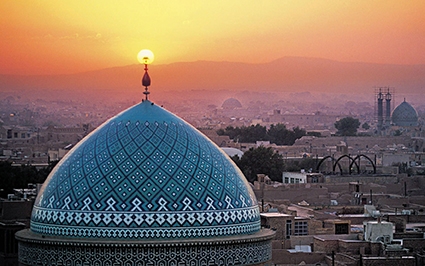Iran’s Growing Role in the Middle East
Op-Ed
In the early 620s AD, the period just before the Arab invasions of the Middle East, the Sasanian Shah, Khusro II, with his large armies, besieged Constantinople, Byzantium's capital, having already occupied Egypt, Syria, Palestine and other former Byzantine lands. This was a momentous event in world history as the Iranians had not reached the Mediterranean Sea since the end of the Achaemenid Empire in 330 BC. However, Iranian success proved to be short-lived, and for the next 1,400 years, the Iranian ambitions were checked, until reports and various hints emerged recently that Iran-backed forces had moved to control the Syria-Iraq border. This is an exceptional moment, as Iran would again be able to have a contiguous land bridge from its proper territory through north Iraq and Syria, right to the Mediterranean coast.
From now on, the Iranians will be able to link-up with their closest allies in Lebanon, Hezbollah. If that scenario is correct then, after 12 years of conflict in Iraq and another conflict in Syria, Iran is steadily transforming into a more powerful geopolitical player whose influence will be projected over hundreds and maybe thousands of kilometers beyond its borders.
However, that is not the full story, as the route is quite complex as it weaves across Arab Iraq, via Iraq’s Kurdish north, into Kurdish north-eastern Syria and through the battlefields north of Aleppo, where Russia, Iran and their allies won an important battle earlier this year.
Putting the Iranian Corridor into Context
To start, geography is a key to understanding the Iranian grand strategy and its ambitions. A look at the map shows that Iran's major population centers are surrounded by almost impregnable mountains and deserts, as well as water barriers. To the west and north-west are the Zagros Mountains, essentially separating Iran from the resource-rich and fertile Iraq. To the north the Elburz Mountains and Armenia's mountainous lands have always served as a defensive shield. The Caspian Sea in the north and the Arabian Sea in the south are yet more impregnable barriers. To the east and north-east, the harsh climate of Afghanistan and Pakistan, alongside Turkmenistan's semi-barren steppe lands, have kept Iran's provinces more or less safe (except for occasional attacks by nomadic peoples).
This advantageous mountainous and desert geography has, however, also limited the projection of Iranian power abroad. Due to poor geographic conditions, there has been no economic or military reason to project Iranian power into Central Asia, or Afghanistan and Pakistan. Thus, strategically, the most advantageous territory for Iran to project its power to has been the western frontier, or modern-day Iraq (Mesopotamia): always rich in population and natural resources and therefore worth controlling. This could at least partially explain Iran’s ambitious ‘corridor’ to the Mediterranean.
Indeed, history shows how crucial Iraq has been in Iran's calculus. Take as an example the Achaemenid Empire, followed by Parthia and the Sasanian State: they all hung to Mesopotamia and even had their capital Ctesiphon located along the Euphrates River near modern-day Baghdad.
Iranians have been always worried about not allowing a foreign presence in the territories surrounding the Iranian plateau. Any foreign influence close to the heart of Iran would be a strategic weakening of the Iranian State. This could also explain Iran's modern behavior and why Tehran is so interested in Iraq.
True, beyond geographic reasons explaining the need to dominate Iraq and Syria and have an outlet to the Mediterranean, there are also pure historical precedents. Within the Achaemenid Empire, the borders reached the Mediterranean. And the last time Iranians were at the sea was the historic moment which I mentioned in the introduction – Khusro II’s near complete devastation of the Byzantines in the 620s.
Emil Avdaliani teaches history and international relations at Tbilisi State University and Ilia State University. He has worked for various international consulting companies and currently publishes articles focused on military and political developments across the former Soviet space and the Middle East.
Emil Avdaliani












